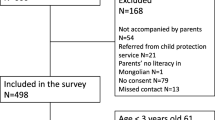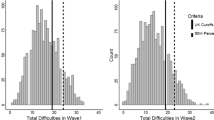Abstract
The extended Strengths and Difficulties Questionnaire (SDQ) provides information on problem behaviours and impairment measures. Western studies found impairment measures to be as good as symptom scores in predicting clinical caseness. The high levels of comorbidities among child psychiatric disorders also meant that disorders not specifically captured by the questionnaire could be identified. This study examines its applicability among Chinese school children in Hong Kong. Results found that impairment measures were more predictive of clinical status than were symptom scores. Children with low symptom but high impairment ratings had profiles that were intermediate between the low symptom low impairment and high symptom low impairment groups. The extended SDQ is useful in identifying children who might otherwise be missed if symptom scores alone were used in screening. The acceptance of child psychiatric care in Hong Kong is a multi-step process that depends on how symptoms are perceived.
Similar content being viewed by others
References
Goodman R (1997) The strengths and difficulties questionnaire: a research note. J Child Psychol Psychiatry 38:581–586
Goodman A, Goodman R (2011) Population mean scores predict child mental health disorder rates: validating SDQ prevalence estimators in Britain. J Child Psychol Psychiatry 52:100–108
Goodman A, Goodman R (2009) Strengths and difficulties questionnaire as a dimensional measure of child mental health. J Am Acad Child Adolesc Psychiatry 48:400–403
Stone LL, Otten R, Engels RCME, Vermulst AA, Janssens JMAM (2010) Psychometric properties of the parent and teacher versions of the strengths and difficulties questionnaire for 4- to 12-years olds: a review. Clin Child Fam Psychol Rev 13:254–274
Goodman R (1999) The extended version of the Strengths and Difficulties Questionnaire as a guide to child psychiatric caseness and consequent burden. J Child Psychol Psychiatry 40:791–799
Goodman R, Ford T, Simmons H, Gatward R, Meltzer H (2000) Using the Strengths and Difficulties Questionnaire to screen for child psychiatric disorders in a community sample. Br J Psychiatry 177:534–539
Hawes DJ, Dadds MR (2004) Australian data and psychometric properties of the strengths and difficulties questionnaire. Aust NZ J Psychiatry 38:644–651
Sayal K (2004) The role of parental burden on service use: longitudinal study. J Am Acad Child Adolesc Psychiatry 43:1328–1333
Lai KYC, Luk ESL, Leung PWL, Wong ASY, Law L, Ho K (2010) Validation of the Chinese version of the strengths and difficulties questionnaire in Hong Kong. J Soc Psychiatry Psychiatric Epidemiol 45:1179–1186
Achenbach T, McConaughy S, Howell CT (1987) Child/adolescent behavioral and emotional problems: implications of cross-informant correlations for situational specificity. Psychol Bull 101:213–232
Timimi S, Taylor E (2004) ADHD is best understood as a cultural construct. Br J Psychiatry 184:8–9
Cheung CS, McBride-Chang C (2008) Relations of perceived maternal parenting style, practices, and learning motivation to academic competence in Chinese children. Merrill-Palmer Q 54:1–22
Mathai J, Anderson P, Bourne A (2004) Comparing psychiatric diagnoses generated by the Strengths and Difficulties Questionnaire with diagnoses made by clinicians. Aust NZ J Psychiatry 38:639–643
Xu Y, Farver JM, Chang L, Zhang Z, Yu L (2007) Moving away of fitting in? Understanding shyness in Chinese children. Merrill-Palmer Q 53:527–556
Angold A, Messer SC, Stangl D, Farmer EMZ, Costello EJ, Burns BJ (1998) Perceived parental burden and services use for children and adolescent psychiatric disorders. Am J Public Health 88:75–80
Sayal K, Goodman R, Ford T (2006) Barriers to the identification of children with attention deficit/hyperactivity disorder. J Child Psychol Psychiatry 47:744–750
Leung PWL, Hung SF, Ho TP, Lee CC, Liu WS, Tang CP, Kwong SL (2008) Prevalence of DSM-IV disorders in Chinese adolescents and the effects of the impairment criteria: a pilot community study in Hong Kong. Eur Child Adolesc Psychiatry 17:452–461
Ho TP, Leung PWL, Luk ESL, Taylor E, Bacon-Shone J, Lieh-Mak F (1996) Establishing the constructs of childhood behavioral disturbances in a Chinese population: a questionnaire study. J Abnorm Child Psychol 24:417–431
Luk ESL, Leung PWL, Lee PLM (1988) Conners’ teacher rating scale in Chinese children in Hong Kong. J Child Psychol Psychiatry 29:165–174
Wille N, Bettge S, Wittchen H-U, Ravens-Sieberer U, the BELLA study group (2008) How impaired are children and adolescents by mental health problems? Results of the BELLA study. Eur Child Adolesc Psychiatry 17(Suppl 1):42–51
Teagle SE (2002) Parental problem recognition and child mental health service use. Ment Health Serv Res 4:257–266
Sayal K (2006) Annotation: pathways to care for children with mental health problems. J Child Psychol Psychiatry 47:649–659
Sourander S, Santalahti P, Haavisto A, Piha J, Ikaheimo K, Helenius H (2004) Have there been changes in children’s psychiatric symptoms and mental health service use? A 10-year comparison from Finland. J Am Acad Child Adolesc Psychiatry 43:134–1145
Conflict of interest
On behalf of all authors, the corresponding author states that there is no conflict of interest.
Author information
Authors and Affiliations
Corresponding author
Rights and permissions
About this article
Cite this article
Lai, K.Y.C., Leung, P.W.L., Luk, E.S.L. et al. Use of the Extended Strengths and Difficulties Questionnaire (SDQ) to Predict Psychiatric Caseness in Hong Kong. Child Psychiatry Hum Dev 45, 703–711 (2014). https://doi.org/10.1007/s10578-014-0439-5
Published:
Issue Date:
DOI: https://doi.org/10.1007/s10578-014-0439-5




